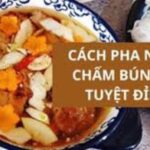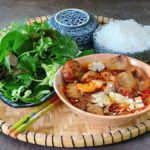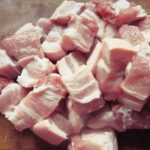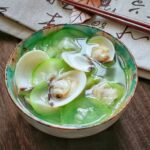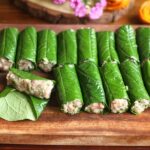Which Part of Pork Should Be Used for Hanoi’s Bun Cha?
For the famous Hanoi dish, Bun Cha, it is best to choose a cut of pork that includes both lean and fatty meat. The belly or shoulder parts are ideal, ensuring the meat remains moist and tender when grilled. Cut the meat across the grain, thin and wide. It is recommended to remove the skin to avoid toughness.
For the minced pork patties, a mixture of fatty shoulder meat and lean meat is perfect, ensuring a delicious, chewy texture. Hand-chopping the meat is preferable to machine-grinding, as it retains a better texture.
Regardless of the cut, always choose fresh, pink pork with a bouncy texture when pressed.

Hanoi Bun Cha features both grilled pork slices and minced pork patties.
Marinade for Hanoi Bun Cha
The traditional marinade for Hanoi Bun Cha is a simple combination of fish sauce, sugar, pepper, and chopped shallots. To enhance the color, a little caramel sauce can be added. Some people also add finely chopped scallions. Unlike other grilled pork dishes, Hanoi Bun Cha does not use garlic or lemongrass in the marinade. Lemongrass is typically used in Southern-style grilled pork dishes.
Nowadays, some people like to experiment with additional ingredients such as oyster sauce, seasoning powder, minced garlic, lemongrass, and honey.
The slices and patties are marinated separately for about 1-2 hours. For an even deeper flavor, you can marinate the meat overnight in the fridge. Cover the bowl tightly to prevent odors from entering.
Additionally, a little oil or pork fat can be mixed with the minced meat to keep it moist.
For 500 grams of meat, the approximate ratio of marinade ingredients is as follows: 1-1.5 tablespoons of fish sauce (adjust according to saltiness), 1.5-2 tablespoons of caramel sauce, 2 tablespoons of yellow or white sugar, 1 teaspoon of pepper, and chopped shallots to taste.
Accompaniments for Hanoi Bun Cha
The typical herbs served with Hanoi Bun Cha include perilla, shiso, elsholtzia, coriander, and Lang basil. Lang basil is a unique herb that enhances the flavor of Bun Cha and is said to be the secret to its distinctive taste. The famous Vietnamese writer Vu Bang once wrote, “‘The basil from Lang is what makes Hanoi’s Bun Cha so special. Basil grown elsewhere loses its unique flavor and becomes minty.’”
In addition to the fresh herbs, Bun Cha is also served with pickled vegetables, typically green papaya (or jicama) and carrots, thinly sliced and marinated in salt, sugar, and vinegar to create a harmonious blend of flavors and textures.
When using green papaya, it is recommended to rub the papaya with salt first for about 6-8 minutes, then rinse to reduce bitterness. After that, marinate the papaya in sugar to maintain crispness before adding the other ingredients such as salt and vinegar.
If using jicama, soak it in sugar first to retain its crunchiness, then add salt and vinegar.
Tips for Grilling the Pork for Hanoi Bun Cha
For the minced pork patties, form the mixture into flat, round shapes. Before placing the patties on the grill, brush the grill with oil to prevent sticking. If available, use split bamboo skewers to hold the patties, as the bamboo imparts a wonderful aroma to the meat.
Place the slices of pork on the grill as well.

Grilling the pork over charcoal flames is the traditional and most flavorful way to cook Hanoi Bun Cha.
Charcoal grilling is the preferred method for cooking the pork to perfection. Place the meat on the grill over the hot coals, turning it occasionally to ensure even cooking and prevent burning.
Additionally, fried spring rolls are often served as a side dish with Bun Cha. During the subsidy period, journalist Vu Thi Tuyet Nhung mentioned in her book, “Ha Thanh Huong Vi Xua Cu,” that fried spring rolls were a common accompaniment to Bun Cha. At that time, Bun Cha was considered a luxurious dish, and people had to save their meat coupons for months to be able to afford it on special occasions. Since meat was scarce, the better-looking cuts were used for the grilled slices, while the scraps were used for the patties and spring rolls. The spring rolls were also bulked up with other ingredients to make the meal more filling.
Type of Noodles Used in Hanoi Bun Cha
Hanoi Bun Cha is typically served with thin, white rice vermicelli, known as “bun roi.” It is not served with wider rice noodles like bún lá or bún con.
The Essential Dipping Sauce for Hanoi Bun Cha
The dipping sauce is a crucial component of Hanoi Bun Cha. It is made by combining fish sauce with sugar, vinegar, garlic, chili, and boiled water to create a harmonious blend of sour, spicy, salty, and sweet flavors.
In the traditional style, the dipping sauce consists only of pure fish sauce, traditional vinegar, and sugar. The ratio of these ingredients depends on personal preference, but the most common ratio is 1:1:1:5 (fish sauce: vinegar: sugar: boiled water). In the past, people used homemade vinegar, which had a milder sourness and a subtle sweetness due to the presence of lactic acid. The renowned writer Vu Bang described the dipping sauce in his book, “Mieng Ngon Ha Noi,” as follows: “‘The key to the deliciousness of Bun Cha lies in its dipping sauce: the fish sauce is not too salty, the vinegar is just right, and a touch of pepper and chili is added. Eating the bun and herbs with this sauce is a smooth and satisfying experience, neither too spicy nor too bland.’”
Today, some people use lime or kumquat juice in the dipping sauce. However, these fruits contain citric acid, which can create a sharper sourness and a stronger aroma that may overpower the other flavors.
During the winter, the dipping sauce can be warmed before serving.
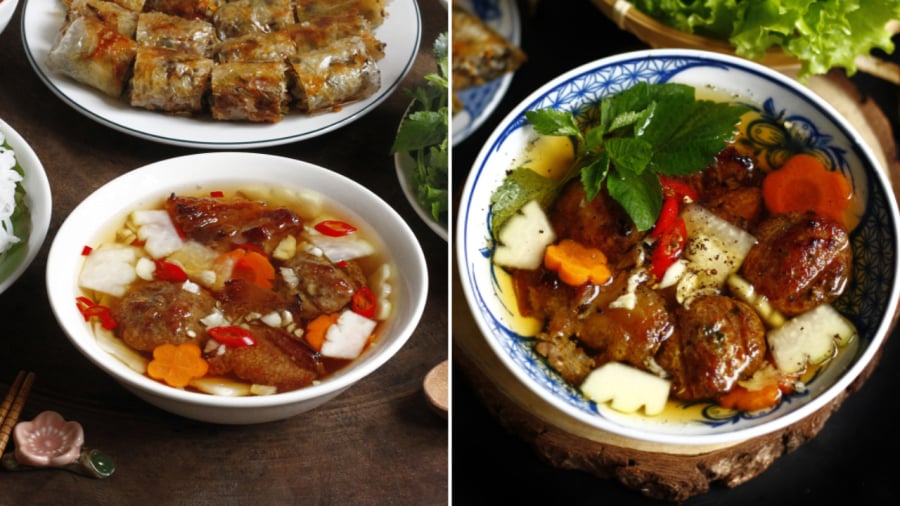
The dipping sauce for Bun Cha is made with fish sauce, vinegar, and sugar.
When serving, add crushed garlic, sliced chili, and pepper to the dipping sauce. If you have cinnamon essence, a drop or two can enhance the aroma and evoke the traditional flavor.
Arrange the noodles, grilled pork, herbs, and pickles on a plate, with the dipping sauce on the side. Let diners adjust the sauce to their taste by adding garlic and chili as desired.

























